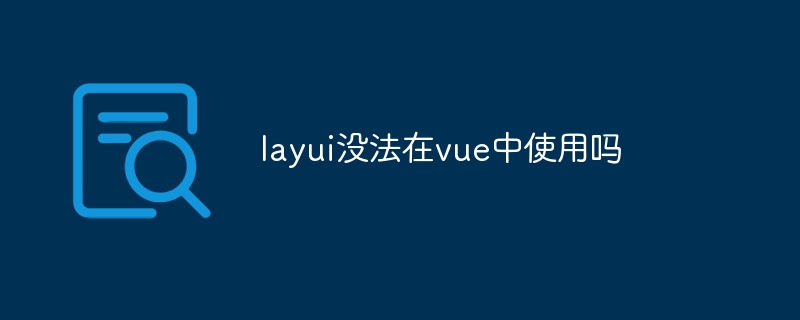Can layui not be used in vue?
It is possible to use layui in Vue. There are two integration methods: use the vue-layui plugin, which provides Vue bindings for the layui API. Manually import layui and register global components. The advantages of integrating layui include simplified control use, improved development efficiency, and easy access to powerful features.

layui Using
layui in Vue?
Yes, layui can be integrated into Vue projects without worrying about compatibility issues.
Integration methods
There are two main ways to integrate layui with Vue:
-
Vue plugin: Install
vue-layuiplug-in, which provides Vue binding for layui API.
Example:import Vue from 'vue'; import VueLayui from 'vue-layui'; Vue.use(VueLayui);
Copy after login Manual integration: Directly import layui into the project and register global components.
Example:import layui from 'layui'; Vue.component('my-layui-component', { template: '<div></div>', created() { layui.form.render(); }, });Copy after login
Notes
- Using the Vue plug-in requires installation and import, but manual integration does not.
- Make sure to register the layui component correctly to avoid conflicts.
- Different layui versions may require different integration methods.
Advantages
The main advantages of integrating layui into Vue include:
- Simplify the use of layui controls.
- Improve development efficiency and code maintainability.
- Easy access to layui’s powerful features.
Example
The following is a simple Vue component using the layui form element:
<template>
<div>
<form class="layui-form">
<label>姓名:</label>
<input type="text" name="name">
<button type="submit" class="layui-btn">提交</button>
</form>
</div>
</template>
<script>
export default {
created() {
layui.form.render();
},
};
</script>By using vue-layui Plug-in to easily access layui API and create complex components:
<template>
<l-table :data="tableData"></l-table>
</template>
<script>
import { lTable } from 'vue-layui';
export default {
components: {
lTable,
},
data() {
return {
tableData: { /* table data */ },
};
},
};
</script>The above is the detailed content of Can layui not be used in vue?. For more information, please follow other related articles on the PHP Chinese website!

Hot AI Tools

Undresser.AI Undress
AI-powered app for creating realistic nude photos

AI Clothes Remover
Online AI tool for removing clothes from photos.

Undress AI Tool
Undress images for free

Clothoff.io
AI clothes remover

AI Hentai Generator
Generate AI Hentai for free.

Hot Article

Hot Tools

Notepad++7.3.1
Easy-to-use and free code editor

SublimeText3 Chinese version
Chinese version, very easy to use

Zend Studio 13.0.1
Powerful PHP integrated development environment

Dreamweaver CS6
Visual web development tools

SublimeText3 Mac version
God-level code editing software (SublimeText3)

Hot Topics
 1378
1378
 52
52
 How to add functions to buttons for vue
Apr 08, 2025 am 08:51 AM
How to add functions to buttons for vue
Apr 08, 2025 am 08:51 AM
You can add a function to the Vue button by binding the button in the HTML template to a method. Define the method and write function logic in the Vue instance.
 How to use bootstrap in vue
Apr 07, 2025 pm 11:33 PM
How to use bootstrap in vue
Apr 07, 2025 pm 11:33 PM
Using Bootstrap in Vue.js is divided into five steps: Install Bootstrap. Import Bootstrap in main.js. Use the Bootstrap component directly in the template. Optional: Custom style. Optional: Use plug-ins.
 How to reference js file with vue.js
Apr 07, 2025 pm 11:27 PM
How to reference js file with vue.js
Apr 07, 2025 pm 11:27 PM
There are three ways to refer to JS files in Vue.js: directly specify the path using the <script> tag;; dynamic import using the mounted() lifecycle hook; and importing through the Vuex state management library.
 How to use watch in vue
Apr 07, 2025 pm 11:36 PM
How to use watch in vue
Apr 07, 2025 pm 11:36 PM
The watch option in Vue.js allows developers to listen for changes in specific data. When the data changes, watch triggers a callback function to perform update views or other tasks. Its configuration options include immediate, which specifies whether to execute a callback immediately, and deep, which specifies whether to recursively listen to changes to objects or arrays.
 How to return to previous page by vue
Apr 07, 2025 pm 11:30 PM
How to return to previous page by vue
Apr 07, 2025 pm 11:30 PM
Vue.js has four methods to return to the previous page: $router.go(-1)$router.back() uses <router-link to="/" component window.history.back(), and the method selection depends on the scene.
 What does vue multi-page development mean?
Apr 07, 2025 pm 11:57 PM
What does vue multi-page development mean?
Apr 07, 2025 pm 11:57 PM
Vue multi-page development is a way to build applications using the Vue.js framework, where the application is divided into separate pages: Code Maintenance: Splitting the application into multiple pages can make the code easier to manage and maintain. Modularity: Each page can be used as a separate module for easy reuse and replacement. Simple routing: Navigation between pages can be managed through simple routing configuration. SEO Optimization: Each page has its own URL, which helps SEO.
 How to use foreach loop in vue
Apr 08, 2025 am 06:33 AM
How to use foreach loop in vue
Apr 08, 2025 am 06:33 AM
The foreach loop in Vue.js uses the v-for directive, which allows developers to iterate through each element in an array or object and perform specific operations on each element. The syntax is as follows: <template> <ul> <li v-for="item in items>>{{ item }}</li> </ul> </template>&am
 How to use function intercept vue
Apr 08, 2025 am 06:51 AM
How to use function intercept vue
Apr 08, 2025 am 06:51 AM
Function interception in Vue is a technique used to limit the number of times a function is called within a specified time period and prevent performance problems. The implementation method is: import the lodash library: import { debounce } from 'lodash'; Use the debounce function to create an intercept function: const debouncedFunction = debounce(() => { / Logical / }, 500); Call the intercept function, and the control function is called at most once in 500 milliseconds.




